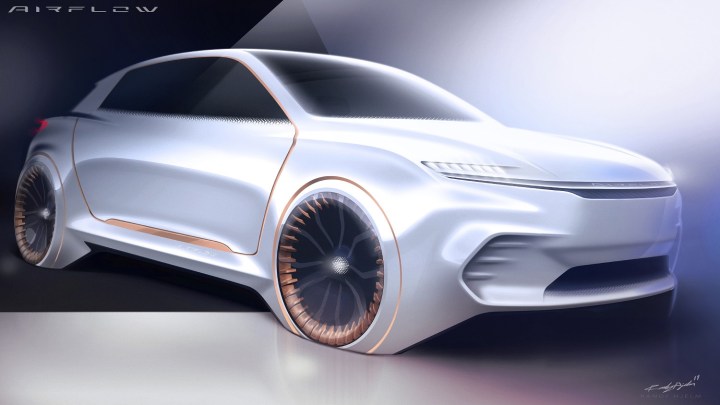
Chrysler will make a surprising appearance at CES 2020 to introduce a concept called Airflow Vision. It signals the direction the American brand — which has been quiet in recent years — will take during the 2020s by channeling its heritage.
The Airflow Vision takes the form of a crossover-like model with a futuristic exterior design that breaks all ties with the two current members of the Chrysler range. The passengers access the four-seater cabin via an extra-wide opening, and they travel on lounge-like seats. The Detroit-based firm explained it asked its stylists to balance technology and serenity.

Four screens face the front passengers — the first replaces the instrument cluster behind the steering wheel, the second dominates the middle part of the dashboard while displaying the infotainment system, the third is a little bit further down to show additional information about the car and its surrounding, and the fourth provides the front passenger with entertainment. That’s a tremendous amount of information to take in, but Chrysler explained it’s far easier to use than it sounds because the menus are logically structured, and they’re customizable, like on a smartphone or a tablet.
The rear passengers each have a screen, too. The driver can share information with the people in the back seats by swiping one of the dashboard-mounted screens. Ambient lighting, spacious for people and gear, and leather upholstery make the Airflow Vision a comfortable place to travel in. It’s about the same size as a Chrysler Pacifica minivan, which seats up to eight people, so putting four seats in such a large footprint gives everyone plenty of room to stretch out.
Chrysler presented the Airflow Vision as a sculptural design concept, which is a vague term that strongly hints the car is non-functional, but we’re pretty sure it’s electric. Zooming in on one of the interior photos shows a diagram of the drivetrain which seemingly consists of a large battery pack mounted under the passenger compartment, and an electric motor over each axle.

The CES-bound concept is very likely electric (or, at least, electrified), full of screens, and highly connected, so what role does heritage play? It’s in the name: Chrysler sold a model named Airflow between 1934 and 1937, and it stood out from every other car on American roads at the time with a surprisingly aerodynamic, forward-thinking design characterized by a rakish silhouette. Motorists weren’t drawn to its aerodynamic lines, they considered the sedan too wild, and a stunningly diverse selection of problems largely linked to the manufacturing process sank the car’s reputation early on.
While there’s little indication that Chrysler will bring the Airflow Vision concept to production, we expect many of the technologies packed in it will reach production as the firm overhauls and expands its range during the 2020s.
Editors' Recommendations
- Genesis Neolun concept is an electric SUV inspired by tradition
- Chrysler Halcyon concept is a return to glory for the minivan brand
- Volkswagen ID.GTI concept is another icon reimagined as an EV
- Mercedes-Benz Vision One-Eleven concept looks to the past for inspiration
- Ram EV concept previews truck brand’s electric future




